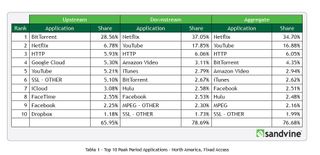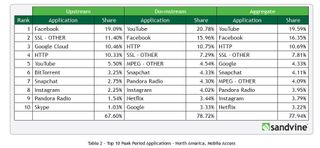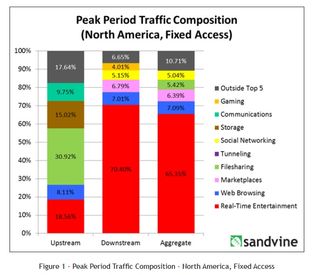Audio, Video Soak Up the Bits

Streaming audio and video services continue to change the complexion of the Internet, almost in real time.
In fact, “real-time entertainment,” a category that includes audio and video, now comprises 70% of the downstream bytes that traverse the Internet during “peak” periods, up from just 35% five years ago, according to bandwidth-management firm Sandvine’s latest Global Internet Phenomena report.
Sandvine, which based its findings on data collected from more than 250 customers worldwide in September and October, found that real-time apps dwarfed activities such as Web browsing, accessing “Marketplaces” (such as Apple iTunes) and even social networking and gaming.
Although new over-the-top video services are emerging on an almost daily basis, make no mistake that Netflix traffic still absorbs most of the bits on fixed broadband networks in North America, and continues to do so by a huge margin.
Netflix accounted for 37.1% of that traffic during primetime hours, slightly ahead of the 36.5% it represented in Sandvine’s last report, the company said. That kept it well ahead of rivals such as YouTube, Amazon Prime Instant Video and Hulu. Netflix also held a healthy lead on an aggregate (upstream and downstream) basis.
“Streaming video has grown at such a rapid pace in North America that the leading service in 2015, Netflix, now has a greater share of traffic than all of streaming audio and video did five years ago,” Sandvine CEO Dave Caputo said, noting that YouTube, Amazon Video and Hulu have also gained.

On the mobile side, real-time entertainment traffic also dominated the downstream, accounting for 40% of the downstream bytes. On an aggregate basis, YouTube led the way, with 19.59% of traffic, followed by Facebook. Netflix, meanwhile, represented just 3.22% of downstream traffic on the mobile side.
Broadcasting & Cable Newsletter
The smarter way to stay on top of broadcasting and cable industry. Sign up below

